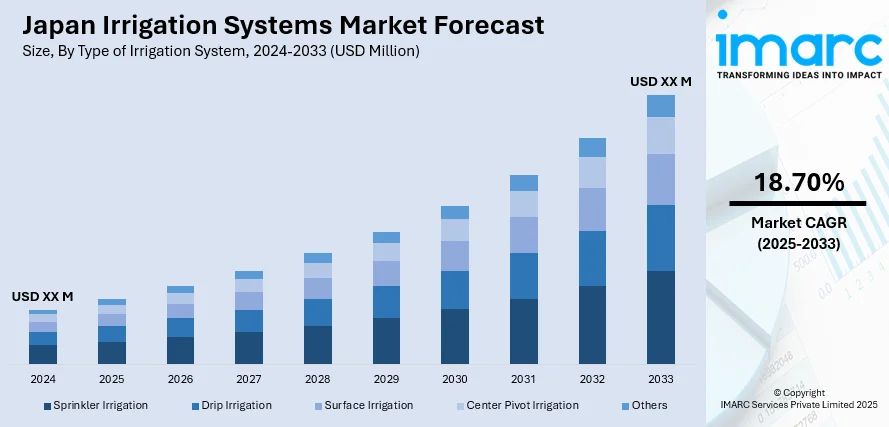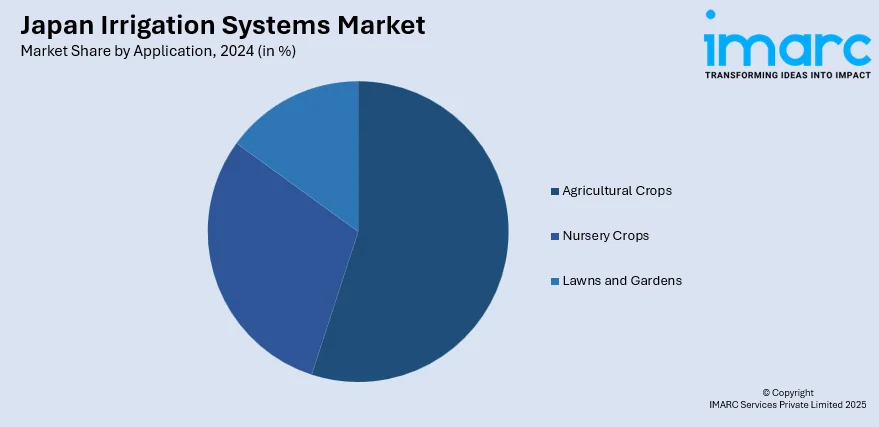
Japan Irrigation Systems Market Size, Share, Trends and Forecast by Type of Irrigation System, Crop Type, Application, and Region, 2025-2033
Japan Irrigation Systems Market Overview:
The Japan irrigation systems market size is exhibiting a growth rate (CAGR) of 18.70% during 2025-2033. The market is evolving rapidly, driven by the adoption of advanced technologies such as smart and micro-irrigation solutions. Increasing focus on sustainable agriculture, water conservation, and government support for modern farming practices, along with climate variability and the need for efficient water management, are also influencing the market. Growing investments by major players in innovation to meet rising demand, are further shaping the competitive landscape of the Japan irrigation systems market share.
|
Report Attribute
|
Key Statistics
|
|---|---|
|
Base Year
|
2024 |
|
Forecast Years
|
2025-2033
|
|
Historical Years
|
2019-2024
|
| Market Growth Rate 2025-2033 | 18.70% |
Japan Irrigation Systems Market Trends:
Technological Advancements in Smart Irrigation
Japan’s irrigation systems market is significantly driven by the integration of smart technologies such as IoT, AI, and automation. These technologies allow for real-time tracking of soil moisture, weather, and crop requirements, which means accurate water delivery. Smart irrigation helps in conserving water and increasing crop yields, keeping in line with Japan's emphasis on sustainable agriculture. Both private innovation and government support through efforts towards digital farming adoption of these technologies are forthcoming. As farmers seek ways to maximize productivity while preserving resources, the need for smart irrigation systems also increases. This is especially prevalent in areas experiencing shortages in labor, where automation presents a pragmatic solution to sustain agricultural efficiency.

To get more information on this market, Request Sample
Government Support and Policy Initiatives
The Japanese government plays a pivotal role in promoting modern irrigation practices through subsidies, research funding, and infrastructure development. Policies to rejuvenate rural economies and food security have seen growing investment in farm technology, including irrigation. Initiatives under the Ministry of Agriculture, Forestry and Fisheries (MAFF) promote the use of water-saving systems, particularly for regions that suffer from drought or have limited water. Furthermore, Japan's environmental sustainability and climate resilience efforts have resulted in more stringent water use regulations, further motivating the transition towards efficient irrigation. Such policy structures establish a supportive setting for market development and innovation in irrigation technologies.
Rising Demand for Water Conservation
Water scarcity and the need for sustainable resource management are critical concerns in Japan, especially in agriculture, which is further driving the Japan irrigation systems market growth. Due to less freshwater and more climate change, it is now a priority to use water efficiently in the country. Many farmers are using drip and micro-irrigation to use water more efficiently. Using such systems limits water usage, uses less energy, and reduces expenses in operation. Further advertising and educational efforts help people realize the importance of using less water and adopt new irrigation techniques. As environmental consciousness grows among consumers and producers alike, the market for water-efficient irrigation solutions is expected to expand steadily.
Japan Irrigation Systems Market Segmentation:
IMARC Group provides an analysis of the key trends in each segment of the market, along with forecasts at the country and regional levels for 2025-2033. Our report has categorized the market based on type of irrigation system, crop type, and application.
Type of Irrigation System Insights:
- Sprinkler Irrigation
- Drip Irrigation
- Surface Irrigation
- Center Pivot Irrigation
- Others
The report has provided a detailed breakup and analysis of the market based on the type of irrigation system. This includes sprinkler irrigation, drip irrigation, surface irrigation, center pivot irrigation, and others.
Crop Type Insights:
- Cereals and Grains
- Fruits and Vegetables
- Oilseeds and Pulses
- Cash Crops
A detailed breakup and analysis of the market based on the crop type have also been provided in the report. This includes cereals and grains, fruits and vegetables, oilseeds and pulses, and cash crops.
Application Insights:

- Agricultural Crops
- Nursery Crops
- Lawns and Gardens
A detailed breakup and analysis of the market based on the application have also been provided in the report. This includes agricultural crops, nursery crops, and lawns and gardens.
Regional Insights:
- Kanto Region
- Kansai/Kinki Region
- Central/ Chubu Region
- Kyushu-Okinawa Region
- Tohoku Region
- Chugoku Region
- Hokkaido Region
- Shikoku Region
The report has also provided a comprehensive analysis of all the major regional markets, which include the Kanto Region, Kansai/Kinki Region, Central/ Chubu Region, Kyushu-Okinawa Region, Tohoku Region, Chugoku Region, Hokkaido Region, and Shikoku Region.
Competitive Landscape:
The market research report has also provided a comprehensive analysis of the competitive landscape. The report covers competitive analysis, including market structure, key player positioning, top winning strategies, a competitive dashboard, and a company evaluation quadrant. Also, detailed profiles of all major companies have been provided.
Japan Irrigation Systems Market News:
- In July 2024, The Japanese ambassador to Armenia, H.E. Aoki Yutaka, toured the Lori region's Ayrum-Chochkan and Chochkan-1 irrigation pumping stations, with UNDP Resident Representative in Armenia, Natia Natsvlishvili, to gain firsthand knowledge of the outcomes of the UNDP-implemented project. The Japanese government provided funding for the transition to low-carbon irrigation methods in the Lori and Shirak districts of Armenia to improve livelihoods, food security, and production.
Japan Irrigation Systems Market Report Coverage:
| Report Features | Details |
|---|---|
| Base Year of the Analysis | 2024 |
| Historical Period | 2019-2024 |
| Forecast Period | 2025-2033 |
| Units | Million USD |
| Scope of the Report |
Exploration of Historical Trends and Market Outlook, Industry Catalysts and Challenges, Segment-Wise Historical and Future Market Assessment:
|
| Type of Irrigation Systems Covered | Sprinkler Irrigation, Drip Irrigation, Surface Irrigation, Center Pivot Irrigation, Others |
| Crop Types Covered | Cereals and Grains, Fruits and Vegetables, Oilseeds and Pulses, Cash Crops |
| Applications Covered | Agricultural Crops, Nursery Crops, Lawns and Gardens |
| Regions Covered | Kanto Region, Kansai/Kinki Region, Central/ Chubu Region, Kyushu-Okinawa Region, Tohoku Region, Chugoku Region, Hokkaido Region, Shikoku Region |
| Customization Scope | 10% Free Customization |
| Post-Sale Analyst Support | 10-12 Weeks |
| Delivery Format | PDF and Excel through Email (We can also provide the editable version of the report in PPT/Word format on special request) |
Key Questions Answered in This Report:
- How has the Japan irrigation systems market performed so far and how will it perform in the coming years?
- What is the breakup of the Japan irrigation systems market on the basis of the type of irrigation system?
- What is the breakup of the Japan irrigation systems market on the basis of crop type?
- What is the breakup of the Japan irrigation systems market on the basis of application?
- What is the breakup of the Japan irrigation systems market on the basis of region?
- What are the various stages in the value chain of the Japan irrigation systems market?
- What are the key driving factors and challenges in the Japan irrigation systems market?
- What is the structure of the Japan irrigation systems market and who are the key players?
- What is the degree of competition in the Japan irrigation systems market?
Key Benefits for Stakeholders:
- IMARC’s industry report offers a comprehensive quantitative analysis of various market segments, historical and current market trends, market forecasts, and dynamics of the Japan irrigation systems market from 2019-2033.
- The research report provides the latest information on the market drivers, challenges, and opportunities in the Japan irrigation systems market.
- Porter's five forces analysis assist stakeholders in assessing the impact of new entrants, competitive rivalry, supplier power, buyer power, and the threat of substitution. It helps stakeholders to analyze the level of competition within the Japan irrigation systems industry and its attractiveness.
- Competitive landscape allows stakeholders to understand their competitive environment and provides an insight into the current positions of key players in the market
Need more help?
- Speak to our experienced analysts for insights on the current market scenarios.
- Include additional segments and countries to customize the report as per your requirement.
- Gain an unparalleled competitive advantage in your domain by understanding how to utilize the report and positively impacting your operations and revenue.
- For further assistance, please connect with our analysts.
 Request Customization
Request Customization
 Speak to an Analyst
Speak to an Analyst
 Request Brochure
Request Brochure
 Inquire Before Buying
Inquire Before Buying




.webp)




.webp)












